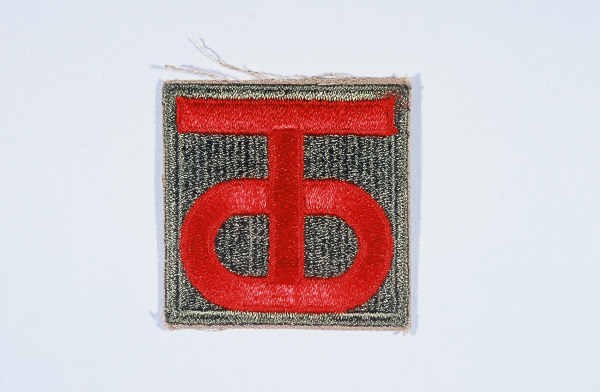The 90th Infantry Division during World War II
In 1985, the United States Holocaust Memorial Museum and the US Army Center of Military History began a program to honor US Army divisions that took part in the Allied liberation of Nazi camps. The US Army Center of Military History defines a liberating division as one whose official records show its presence at a camp within 48 hours of the first soldier’s arrival. The 90th Infantry Division is among the 36 US divisions that have been recognized to date.
Key Facts
-
1
US, British, Soviet, and Canadian troops encountered concentration camps and other sites of Nazi crimes as they advanced across Europe in 1944 and 1945.
-
2
The Allied soldiers liberated sick and starving camp prisoners from Nazi tyranny. They also provided them with food, clothing, and medical aid.
-
3
The United States Holocaust Memorial Museum and the US Army Center of Military History have recognized 36 US divisions for their role in the liberation of Nazi camps.
90th Infantry Division Campaigns during World War II
The 90th Infantry Division was activated in summer 1917, just months after the United States entered World War I. It participated in several military campaigns in France. During World War II, the "Tough Ombre" division landed at Utah Beach on D-Day (June 6, 1944) as part of the massive Allied invasion of western Europe. After pushing through northern France, the unit advanced into the Saar region of Germany, but was redeployed to Belgium during the German offensive into the Ardennes (the Battle of the Bulge). The 90th returned to Germany and captured the city of Mainz on March 22, 1945. Several days later, the "Tough Ombre" division crossed the Rhine and subsequently moved southward into Bavaria and then eastward into Czechoslovakia.
The 90th Infantry Division and the Liberation of Flossenbürg
On April 23, 1945, the 90th overran the Flossenbürg concentration camp, finding about 1,500 prisoners who had not been evacuated on death marches. The unit's journal recorded that one of its motorized patrols entered the camp that day and found "a serious typhus epidemic" in "full swing." The troops interviewed the surviving inmates, who estimated that Flossenbürg had held some 16,000 prisoners before the SS guards evacuated the camp on April 20. The SS had forced the prisoners to work in a nearby stone quarry and in a Messerschmitt plane factory, making fighter craft for the German air force.
After liberating Flossenbürg, the 90th discovered more evidence of Nazi atrocities as they advanced farther. Just prior to the camp's liberation the SS guards had forced some 14,000 inmates to march southward. The 90th and other army divisions found some 6,000 of these prisoners alive. They also discovered the bodies of more than 5,000 inmates, who had died from exhaustion or starvation or had been killed by the SS guards because they failed to keep up with the pace of the march.
Recognition as a Liberating Division
The 90th Infantry Division was recognized as a liberating unit by the US Army's Center of Military History and the United States Holocaust Memorial Museum in 1985.
90th Infantry Division Battle Casualty Figures
Hundreds of thousands of US servicemen and women died or were wounded in the fight against Nazi tyranny.
The total number of battle casualties for the 90th Infantry Division in the European Theater of Operations during World War II was 19,200. In this case, “battle casualties” includes all personnel who were unable to fight in battle because they were wounded, missing, captured, or killed.
Among the battle casualties suffered by the 90th Infantry Division, there were 3,951 deaths.
90th Infantry Division Nickname and Insignia
Nicknamed the "Tough Ombres," the 90th Infantry Division was raised from draftees from the states of Texas and Oklahoma during World War I. The divisional insignia or patch was adopted in 1918. It is in the shape of a square with a green background. The patch incorporates the red letters "T" (for Texas) and "O" (for Oklahoma). Later, these letters yielded the nickname "Tough Ombres." The nickname was meant to refer to the fighting spirit of the unit. During World War II, the 90th was also sometimes called the “Texas’ Own” division or the "Alamo" division. This was a reference to the historic mission and site of the famous battle in 1836 between Texans and the Mexican army in San Antonio, Texas.

Footnotes
-
Footnote reference1.
In the aftermath of World War II, the US Department of the Army compiled casualty figures for US Army personnel. The US government published these figures in 1953. The report listed casualty numbers for the US Army for the period from December 7, 1941 (Pearl Harbor) through December 31, 1946, when US President Harry S. Truman officially declared the end of war hostilities. Army Battle Casualties and Nonbattle Deaths: Final Report, 7 December 1941-31 December 1946, Prepared by the Statistical and Accounting Branch, Office of the Adjutant General, Under the Direction of the Program Review and Analysis, Division of the Comptroller of the Army, O.C.S., (Washington: Department of the Army, 1953), p. 3-4, 84-89.
Critical Thinking Questions
What challenges did Allied forces face when they encountered the camps and sites of other atrocities?
What challenges faced survivors of the Holocaust upon liberation?

